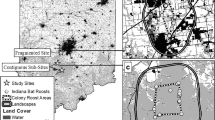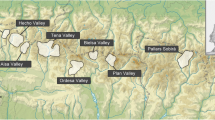Abstract
From 1992–1996, 3204 artificial roosts of 9 types were placed in woodlots near Indianapolis International Airport in an effort to provide habitat for the federally-endangered Indiana myotis (Myotis sodalis) and to determine the feasibility of using these structures to manage bats in a rapidly developing suburban area. We surveyed these structures at least annually during 1992–1999 and found only northern myotis (Myotis septentrionalis) regularly using the structures. Four other species were occasionally found using structures including big brown bats (Eptesicus fuscus, n = 14 individuals), little brown myotis (Myotis lucifugus, n = 2), Indiana myotis (Myotis sodalis, n = 2), and one silver-haired bat (Lasionycteris noctivagans). Single, triple, and Missouri-style batboxes were almost always used, rather than the six other types of experimental roosts that had been in place. However, after 10 years in place, it appears that Indiana bats are acclimated to boxes, as 6 of them were being used rather regularly by Indiana myotis. Bat boxes can provide roosting habitat for some species under conditions where few suitable roosts exist, but assuring an abundance of natural habitats is usually more desirable for conservation of tree-roosting bats.

Similar content being viewed by others
Literature Cited
Arnett E. B., J. P. Hayes. 2000. Bat use of roosting boxes installed under flat-bottom bridges in western Oregon. Wildlife Society Bulletin 28:890–894
Brack V., Jr., J. C. Carter. 1985. Use of an underground burrow by Lasionycteris. Bat Research News 26:28–29
Brittingham M. C., L. M. Williams. 2000. Bat boxes as alternative roosts for displaced bat communities. Wildlife Society Bulletin 28:197–207
Butchkoski C. M., J. M. Hassinger. 2002. Ecology of a maternity colony roosting in a building. in A. Kurta, J. Kennedy Eds., The Indiana bat: biology and management of an endangered species. Bat Conservation International, Austin, Texas Pages 130–142
Carter T. C., G. Feldhamer, J. Kath. 2001. Notes on summer roosting of Indiana bats. Bat Research News 42:197–198
Foster R. W., A. Kurta. 1999. Roosting ecology of the northern bat (Myotis septentrionalis) and comparisons with the endangered Indiana bat (Myotis sodalis). Journal of Mammalogy 80:659–672
Fujita M. S., T. H. Kunz. 1984. Pipistrellus subflavus. Mammalian Species No. 228:1–6
Hall, J.S. 1962. A life history and taxonomic study of the Indiana bat, Myotis Sodalis. Reading Public Museum and Art Gallery, Scientific Publications 12:1–68
Harvey M. J. 2002. Status and ecology in the southern United States. in A. Kurta, J. Kennedy Eds., The Indiana bat: biology and management of an endangered species. Bat Conservation International, Austin, Texas. Pages 29–34
Hendricks W. D., R. Ijames, L. Alverson, J. Timpone, M. Muller, N. Nelson, J. Smelser. 2005. Notable roosts for the Indiana bat (Myotis sodalis). Pages 133–138 in K. C. Vories, A. Harrington (eds). The Indiana bat and coal mining: a technical interactive forum. Office of Surface Mining, US Department of the Interior, Alton, Illinois
Humphrey S. R. 1975. Nursery roosts and community diversity of nearctic bats. Journal of Mammalogy 56:321–346
Humphrey S. R., A. R. Richter, J. B. Cope. 1977. Summer habitat and ecology of the endangered Indiana bat, Myotis sodalis. Journal of Mammalogy 58:334–346
Kurta, A. 2005. Roosting ecology and behavior of Indiana bats (Myotis sodalis) in summer. Pages 29–42 in K. C. Vories and A. Harrington (eds). The Indiana bat and coal mining: a technical interactive forum. Office of Surface Mining, US Department of the Interior, Alton, Illinois
Kurta A., J. Kath, E L. Smith, R. Foster, M. W. Orick, R. Ross. 1993. A maternity colony of the endangered Indiana bat (Myotis sodalis) in an unshaded, hollow, sycamore tree (Platanus occidentalis). The American Midland Naturalist 130:405–407
Lacki M. J., J. H. Schwierjohann. 2001. Day-roost characteristics of northern bats in mixed mesophytic forest. Journal of Wildlife Management 65:482–488
Mumford R. E., J. O. Whitaker Jr. 1982. Mammals of Indiana. Indiana University, Bloomington, Indiana
Pierson E. D. 1998. Tall trees, deep holes and scarred landscapes. Conservation biology of North American bats. in T. H. Kunz P. A. Racey Eds., Bat biology and conservation. Smithsonian Institution Press, Washington, D.C., USA, and London, U.K. Pages 309–325
Ritzi, C.M., B.L. Everson and J.O. Whitaker, Jr. 2005. Use of Bat boxes by a maternity colony of Indiana myots (Myotis Sodalis). Northeaslern Naturalist 12:217–220
Salyers J., K. Tyrell, V. Brack Jr. 1996. Artificial roost structure use by Indiana bats in wooded areas in central Indiana. Bat Research News 37:148
Sasse D. B., P. J. Pekins. 1996. Summer roosting ecology of northern long-eared bats (Myotis septentrionalis) in the White Mountain National Forest. in R. M. R. Barclay, R. M. Brigham Eds., Bats and Forests Symposium. Research Branch, Ministry of Forests, Victoria, British Columbia, Canada. Pages 91–101
Sparks D. W., J. A. Laborda, J. O. Whitaker Jr. 1998. Bats of the Indianapolis International Airport as compared to a more rural community of bats at Prairie Creek. Proceedings of the Indiana Academy of Science 107:171–179
Sparks J. K. F., B. J. Foster, D. W. Sparks. 2004. Utility pole used as a roost by a northern myotis, Myotis septentrionalis. Bat Research News 45:94
Whitaker J. O., Jr. 1998. Life history and roost switching in six colonies of eastern pipistrelles in buildings. Journal of Mammalogy 79:651–659
Whitaker J. O., Jr., V. Brack Jr. 2002. Distribution and summer ecology in Indiana. in A. Kurta, J. Kennedy Eds., The Indiana bat: biology and management of an endangered species. Bat Conservation International, Austin, Texas. Pages 48–54
Whitaker J. O., Jr., S. L. Gummer. 1989. Bat colonies in Indiana with emphasis on the evening bat, Nycticeius humeralis. Proceedings of the Indiana Academy of Science 98:595–598
Whitaker J. O., Jr., W. J. Hamilton Jr. 1998. Mammals of the Eastern United States. Comstock Press, Ithaca, New York
Whitaker J. O., Jr., D. W. Sparks, V. Brack Jr. 2004. Bats of the Indianapolis International Airport Area, 1991–2001. Proceedings of the Indiana Academy of Science 113:151–161
Acknowledgments
The authors are indebted to the Indianapolis International Airport and the Indianapolis Airport Authority for funding and for other support during the course of this project. Work was done under animal use and care permit 09-13-04. Particular thanks are extended to E. Roberts for initiation of the project and to M. Brethauer for help and support throughout the study. S. Pruitt, U.S. Fish and Wildlife Service, supported the concept of a large-scale study of structures for their potential benefit for conservation of the Indiana bat. J. L. Chew, B. L. Emery, J. K. Farrell, B. J. Foster, C. L. Gummer, S. L. Gummer, J. A. Laborda, M. T. Slater, E. R. Stinson, and W. A. Ulrey participated in data collection. At initiation of the study, J. MacGregor shared with us his attempts to use a variety of structures to attract roosting bats in Daniel Boone National Forest. An earlier draft of this manuscript benefited from the comments of T. C. Carter and an anonymous reviewer.
Author information
Authors and Affiliations
Corresponding author
Rights and permissions
About this article
Cite this article
Whitaker, J.O., Sparks, D.W. & Brack, V. Use of Artificial Roost Structures by Bats at the Indianapolis International Airport. Environmental Management 38, 28–36 (2006). https://doi.org/10.1007/s00267-005-0117-2
Published:
Issue Date:
DOI: https://doi.org/10.1007/s00267-005-0117-2




